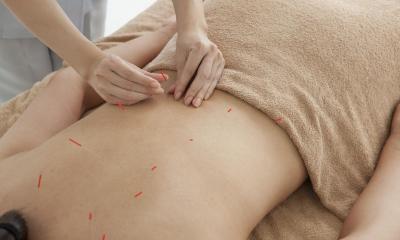
Acupuncturists treat people suffering from chronic pain and a range of other conditions, as well as people looking to lose weight or stop smoking. Our practical guide will help you start up and run your own acupuncture practice.
- Research your target market
- Patient profile
- Complementary and alternative medicine
- Pricing policy
- Buy an existing business
Research your target market
Estimating demand
It's very important to find out whether there is enough demand for an acupuncture practitioner in your area. Acupuncture is available from a number of different sources and you will be competing against:
- other acupuncture practitioners, in both Chinese and Western disciplines
- health professionals such as GPs, nurses and physiotherapists
You may also be competing against many other therapists offering a range of complementary and alternative medicine (CAM) therapies such as aromatherapy, homeopathy or reflexology. A search on Yell.com will give you an indication of the number of acupuncturists and other complementary therapists that are already practising.
You could also use the Find a Practitioner tools on the Complementary & Natural Healthcare Council (CNHC) or the Acupuncture Society websites to check out the number of acupuncturists in your area.
It may be that you will only be competing directly against some of these practitioners because you will be offering very specialised treatments. For example, you might concentrate on helping people with musculo-skeletal disorders, or specialise in auricular acupuncture to assist patients with weight loss or giving up smoking.
Have a good look at existing acupuncture clinics to establish:
- what type of acupuncture they practise
- how much they charge
- how professional they are - at present anyone can set themselves up as an acupuncturist but reputable practitioners will belong to an organisation such as the British Acupuncture Council
- whether the premises are hygienic and smart
- what other therapies they offer
Working alongside GPs and other health professionals
The use of complementary and alternative medicine, including acupuncture, has increased considerably in recent years and many GPs now offer acupuncture treatments themselves. Acupuncture is also offered in hospital pain clinics and by healthcare organisations such as cancer charities that offer support to cancer patients. It would be a good idea to contact your local GPs to see if they would be prepared to refer patients to you, for example in cases where a patient specifically requests acupuncture, or where it is felt that acupuncture would complement conventional treatment. In some cases acupuncture is offered because conventional treatment has failed or produces unacceptable side effects. Recently the NHS recommended acupuncture as a treatment to consider for low back pain that lasts for more than six weeks. Research has also shown that acupuncture can effectively treat chronic back and neck pain, osteoarthritis, shoulder pain and headache. You could direct GPs who might be interested in referring patients to you to the Healthcare Professionals section of the British Acupuncture Council (BAcC) website. This contains details of how acupuncture could benefit their patients.
Research current trends, plus legal and tax issues
Patient profile
Your market
Your patients are likely to come from a broad cross section of the population unless you decide to specialise in particular treatments such as pain relief, smoking cessation, fertility treatment, sports performance, weight loss or drug rehabilitation. Acupuncture is used to treat a wide range of disorders so you are likely to treat patients of all ages and backgrounds.
Some of your patients may be referred to you by their GP, although in many cases they will have to pay for their treatment themselves (some may be able to reclaim the cost from their health insurance company).
Consultations
It is normal practice for acupuncture practitioners to offer a free 'mini' consultation of 15 to 20 minutes or so. This is generally a fairly informal chat about acupuncture, how it works and whether, in broad terms, it would be appropriate to treat the patient's complaint.
If the patient decides to go ahead, you will make an appointment for a longer period, say between one and a half and two hours, during which you will examine the patient, take their pulse, and take details of their symptoms, lifestyle, diet and so on to help you identify any energy imbalances and to decide on the appropriate course of treatment. This is referred to as the initial consultation and diagnosis. Subsequent sessions are shorter than this first one, typically lasting up to one hour. The number of sessions required depends on the nature of the ailment and the individual's response to the treatment.
You may be prepared to visit your patients at home if they have mobility problems. Some acupuncturists regularly treat elderly patients who are residents in care or nursing homes. Acupressure - which is a non-invasive therapy - is particularly effective in helping dementia patients, where it is not possible to use acupuncture needles.
Many acupuncturists offer evening clinics so that patients can attend appointments after work.
Special offers and discounts
You may decide to keep your fees as low as possible for certain patients on low incomes, for example if you specialise in drug rehabilitation. You might also be prepared to reduce the fee you charge per session if the treatment you have decided on will need very many appointments. Another way might be to offer a discount on every third treatment, if a patient is having weekly or fortnightly sessions.
Complementary and alternative medicine
Complementary and alternative medicine (CAM) covers a large number of different therapies, which work holistically by balancing a patient's physical, emotional and spiritual state. The most established disciplines are acupuncture, herbalism, homeopathy, chiropractic and osteopathy, although there are many others. You might decide to offer several therapies in addition to acupuncture - you may have the training and expertise to offer these yourself or you may engage the services of other practitioners. A brief description of some CAM therapies is included below:
Acupuncture
Acupuncture originated in China some 3,000 years ago and involves inserting very fine stainless steel needles into particular points on the body to stimulate nerve impulses. Traditional Chinese medicine is based on the concept of vital energy (or qi) which flows around the body along invisible channels (or meridians). Well being is achieved by regulating the flow of energy and correcting any imbalances by inserting the needles at specific points on the body. Akabani sticks may be used on fingers and toes to test whether or not the flow of qi is symmetric. Dried mugwort or moxa may be used to heat the needle, to reduce or increase the flow of energy. Western acupuncture uses the same needling techniques but affects nerve impulses and the central nervous system. Acupuncture is used to treat a wide range of ailments and conditions, including back and neck pain, osteo-arthritis, allergies, pain relief and smoking cessation. Cosmetic or facial acupuncture can be used to improve skin conditions and to combat the signs of ageing.
Osteopathy
Osteopathy is a system of diagnosis and treatment, primarily for musculo-skeletal problems. Treatment consists of manipulation to correct the underlying causes of the pain - this may include massage, stretching and other exercises.
Chiropractic
Chiropractic treats musculo-skeletal disorders by manipulating and massaging the muscles, joints and ligaments of the body to put right any dysfunction of the spine and pelvis.
Herbal medicine
Herbal medicine uses remedies produced from plants to both treat complaints and to maintain good health.
Homeopathy
Homeopathic treatment uses very small doses of substances that, if taken in high doses by a healthy person, would produce the symptoms that the remedies are designed to treat. It is based on treating "like with like".
Other complementary therapies include:
- aromatherapy
- hypnotherapy
- Alexander technique
- reflexology
- Shiatsu massage
- yoga
- healing
- Traditional Chinese Medicine (TCM) which includes acupuncture, herbal medicine, massage and the exercise technique called Qigong
- naturopathy
- meditation
- nutritional medicine
and many others.
You can find out more about CAM therapies on the NHS Choices website.
Pricing policy
How will you decide on your fees?
Getting the fees right is very important. It's essential to make sure that your fees cover all of your operating costs, including your own drawings. However, many of your patients may be pensioners or those on low incomes and you will have to make sure that your fees are affordable.
Typical fees might be as follows:
- Initial consultation and diagnosis - £40 to £60
- Follow-up treatments - £30 to £50
- Home visits - around £45 to £65
As part of your market research it would be a good idea to check out the fees charged by existing acupuncture practitioners. For example, in some areas - such as London - initial consultation fees might be over £70, while follow-up treatments might be charged at between £50 and £60.
If you plan to regularly offer a discount from your normal tariff (for example to patients aged over 65, or if patients pay for a number of sessions in advance), it makes sense to keep comprehensive details of this.
It's a good idea to offer sales of gift vouchers - this can help bring new patients to your practice.
Buy an existing business
You might decide to buy an existing farm supply business rather than start your own venture from scratch. Buying a going concern can mean that the products, customers, regular sales, staff, premises and equipment are already in place.
But buying a business can be a hazardous, expensive process unless you have the right skills and experience on your team, including legal and financial know-how. Establish the genuine trading and financial position, so that the price you pay for the business is not too high.


